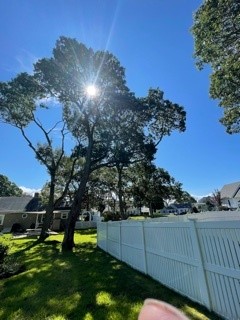-

Having a tree in your home helps to beautify it and it can also serve as a shade to you. All trees have roots and they tend to grow slowly but they can damage your home when the ground around them starts to shift.
Tree roots can damage your plumbing system, pavement, backyard, and foundation and the cost of repairing these damages can be quite high, that is why you need to properly plan before planting trees in certain areas of your home and a tree service company near you can help with that.
Do you want to know how tree roots can damage your home? Let’s dive in!
- Plumbing damage
Many houses that humans occupy have a form of drainage system that helps to dispose of sewage and water. And by design, tree roots are attracted to them especially if you stay in an area that doesn’t experience rainfall often. This is because tree roots move towards areas where they can easily tap water from–they need that water so they can help the tree grow. Aspens, maples, and willows are some species of trees that are very invasive–their root systems can grow to any length to look for water. Most high-quality drainage-field pipes are designed with little holes in them so they can permit easy movement of the wastewater from your house’s interior plumbing to the ground. Tree roots can easily grow into these holes or perforations and they can entirely block the pipes and render them useless. Most old clay pipes that have weak joints can easily be invaded by tree roots thus causing cracks in them.
Don’t underestimate the power of certain tree roots, they can damage the plumbing system in your home that you spent a lot of money on.
- Damage to your foundation and building
Although tree roots grow slowly they are very good at exerting a significant amount of pressure around the area they grow on. When tree roots make movements in the ground to search for nutrients and water, they distort the soil around them. While clay soil is stronger in withholding the pressure tree roots exert on them, dry or loose soil that is found in arid climates, don’t.
It is not tree roots that directly damage the foundation of your home but it is the pressure they exert on the soil they grow on that causes the damage. When the soil these tree roots grow on, gets displaced, they start to affect the strength of the foundation of the building closest to them. Soz as the soul makes any movement, whatever is on that soil, moves too.
If the foundation of your house is not deep enough to withstand the pressure that the tree roots exert on the soil under it, it will likely damage your home.
- Damage to landscape
Trees indeed beautify the landscape view in your home but sometimes their roots can overtake other parts of your home that are meant for other plants to grow on, thus stunting their growth or even making them die. When trees grow very close to each other, they tend to fight for limited nutrients and water from the soil and this will damage the landscape of your home. Usually, tree roots don’t invade solid concrete pavement or walkways but they may get distorted as a result of the soil movement that the tree roots cause.
How you can prevent tree root-related damage in your home
There are several ways you can protect your home from the potential damage that tree roots can do to it.
Here are several ways you can prevent tree root-related damage in your home:
- Create a root barrier
Creating a root barrier around your home is a great way of preventing tree roots from damaging them. To build this root barrier, you. need to dig towards the base of your house foundation, while digging for the root barrier, be cutting away the tree roots that are already growing towards the foundation of your building. Doing this is quite difficult but it is better than staying idle and expecting that the roots of the tree won’t damage your home.
- Plant trees with less invasive roots
If you are still planning about planting a new tree in your home, to prevent any form of tree root damage to your home, you should plant trees with less invasive roots. You can plant sugar maple trees or oak trees whose roots grow very slowly. Don’t plant elm trees, silver maple trees, or willows whose roots spread deeply as they grow.
- Reconsider the option of planting trees in your home
A lot of tree roots spread widely as they grow so if you intend to plant trees in your home, you must check how big your yard is. If your yard is too small to accommodate the subsequent expansion of the tree roots, then you should not plant that tree in the first place or you can consider planting a smaller tree with a separate landscaping option entirely. Certain trees can develop roots that are about two to three times their height.
- Build a house with a deep foundation
Many people are so quick in building their houses that they neglect to build a house with a deep foundation. Building a house with a deep foundation is another way you can prevent tree roots from damaging it later. Houses that have full basements are less vulnerable to root damage and concrete settling than homes that have shallow foundations. Houses that have shallow foundations are more vulnerable to dried-out shifts and soil conditions, but houses that have full basements provide better structural protection.
- Plant trees that are 50 feet away from your structures
It is always good you make plans towards preventing tree roots from damaging your home and one way you can practice that is by planting trees that are at least 50 ft. Away from your home. Don’t plant trees close to your plumbing system, or foundation. When you plant trees very far from your home, they will pose less threat to your property.
- Cut down the tree
Let cutting down the tree in your home be your last option. When you cut down the tree, ensure you get rid of plenty of the root system before you try to repair the structures that were damaged by the tree roots. Also, brush chipping after a tree removal session is carried out it very necessary to keep the environment beautiful.
Conclusion
Tree roots are very powerful, if you don’t want them to invade the foundation of your home, plumbing system, and many other things, then, you should take your time to properly plan the kind of trees you can plant in your home, the right spot they should be planted and many other things you should consider.
You should consult a professional tree service company that can help you examine your home for any potential damage and help create a great plan of action that is suitable for you. Sometimes, they may recommend a tree trimming, tree removal, tree felling or a tree surgery process on the tree. If your tree is removed or trimmed, it is very important that you conduct brush chipping around the area it was done so the place can look appealing.
Are Trees Damaging Your Property?
Sometimes one bad tree can damage your entire landscape and even your home. Consult with our trained staff for a free assessment
Available 24/7 for Emergency Service
Did lightning strike? That’s our specialty. One call and we will dispatch our emergency response team to handle all your emergency tree service needs
Hours
Monday: 7:30am - 6:30pm
Tuesday: 7:30am - 6:30pm
Wednesday: 7:30am - 6:30pm
Thursday: 7:30am - 6:30pm
Friday: 7:30am - 6:30pm
Saturday: 7:30am - 6:30pm
Sunday: Closed
We Are Serving Plymouth, MA | Milton, MA | Canton, MA
Copyright © 2022 - Lighting Strikes Tree LLC. All Rights Reserved.

